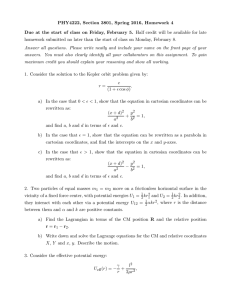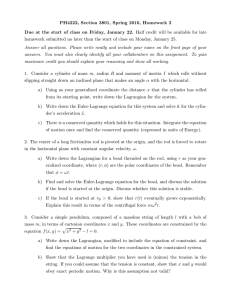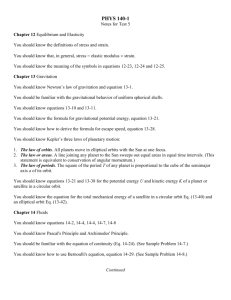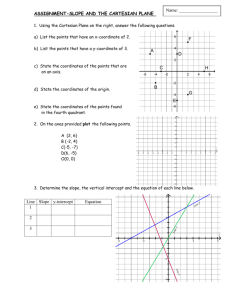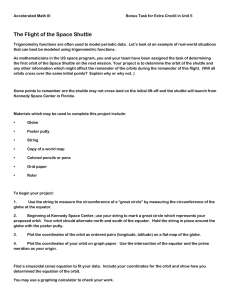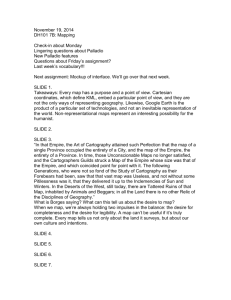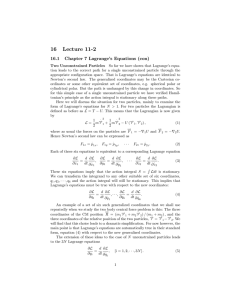PH6246, Section 3916, Fall 2015, Homework 3
advertisement
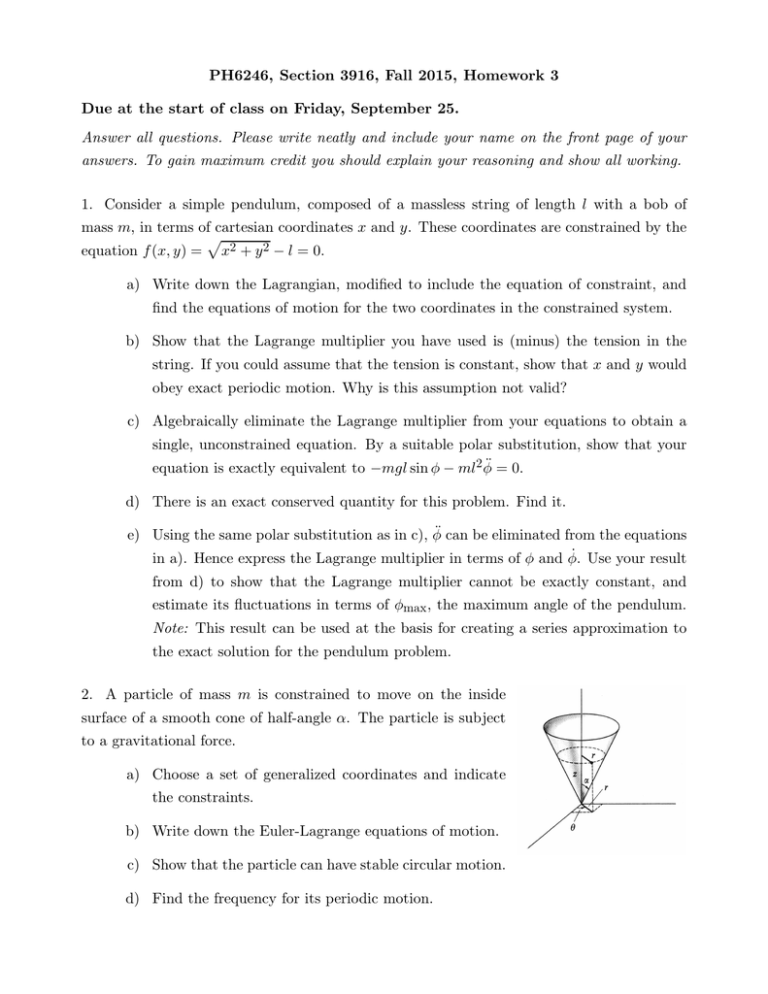
PH6246, Section 3916, Fall 2015, Homework 3 Due at the start of class on Friday, September 25. Answer all questions. Please write neatly and include your name on the front page of your answers. To gain maximum credit you should explain your reasoning and show all working. 1. Consider a simple pendulum, composed of a massless string of length l with a bob of mass m, in terms of cartesian coordinates x and y. These coordinates are constrained by the p equation f (x, y) = x2 + y 2 − l = 0. a) Write down the Lagrangian, modified to include the equation of constraint, and find the equations of motion for the two coordinates in the constrained system. b) Show that the Lagrange multiplier you have used is (minus) the tension in the string. If you could assume that the tension is constant, show that x and y would obey exact periodic motion. Why is this assumption not valid? c) Algebraically eliminate the Lagrange multiplier from your equations to obtain a single, unconstrained equation. By a suitable polar substitution, show that your equation is exactly equivalent to −mgl sin φ − ml2 φ̈ = 0. d) There is an exact conserved quantity for this problem. Find it. e) Using the same polar substitution as in c), φ̈ can be eliminated from the equations in a). Hence express the Lagrange multiplier in terms of φ and φ̇. Use your result from d) to show that the Lagrange multiplier cannot be exactly constant, and estimate its fluctuations in terms of φmax , the maximum angle of the pendulum. Note: This result can be used at the basis for creating a series approximation to the exact solution for the pendulum problem. 2. A particle of mass m is constrained to move on the inside surface of a smooth cone of half-angle α. The particle is subject to a gravitational force. a) Choose a set of generalized coordinates and indicate the constraints. b) Write down the Euler-Lagrange equations of motion. c) Show that the particle can have stable circular motion. d) Find the frequency for its periodic motion. 3. Consider the solution to the Kepler orbit problem given by: r= c . (1 + ǫ cos φ) a) In the case that 0 < ǫ < 1, show that the equation in cartesian coordinates can be rewritten as: (x + d)2 y 2 + 2 = 1, a2 b and find a, b and d in terms of ǫ and c. b) In the case that ǫ = 1, show that the equation can be rewritten as a parabola in cartesian coordinates, and find the intercepts on the x and y-axes. c) In the case that ǫ > 1, show that the equation in cartesian coordinates can be rewritten as: (x + d)2 y 2 − 2 = 1, a2 b and find a, b and d in terms of ǫ and c. 4. Consider the effective potential energy: γ l2 Ueff (r) = − + , r 2µr 2 Where γ represents the strength of the attractive force between the Sun and a planet (or comet), l is the angular momentum of the system and µ is the reduced mass. a) Write down an equation representing the conservation of energy for the reduced system. b) Hence, find the radius at which a planet (or comet) with system angular momentum l can orbit the Sun in a circular orbit with fixed radius. Hint: Look at dUeff /dr. c) Show that this circular orbit is stable, in the sense that a small radial nudge will cause only small radial oscillations. Hint: It may help to differentiate your result from a) to obtain an equation for the acceleration, and express it in terms of a small amplitude displacement away from the equilibrium orbit. d) Show that the period of these oscillations is equal to the planets orbital period. 5. A particle of mass m moves with angular momentum l in the field of a fixed force center with F (r) = −γ/r 2 + λ/r 3 , where γ and λ are positive. a) Write down the transformed radial equation (i.e., d2 u/dφ2 = ..., where u = 1/r). 2 b) Prove that the orbit has the form: r(φ) = c 1 + ǫ cos(βφ) where c, β and ǫ are positive constants. c) Find c and β in terms of the given parameters, and describe the orbit for the case that 0 < ǫ < 1. d) For what values of β is the orbit closed? e) What happens to your results as λ → 0? 3
